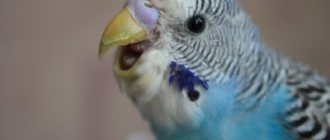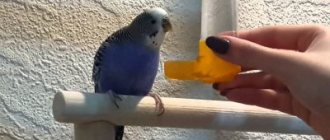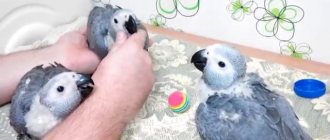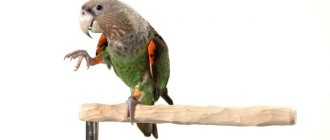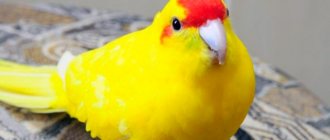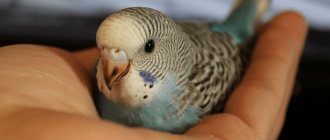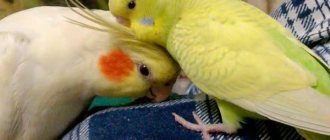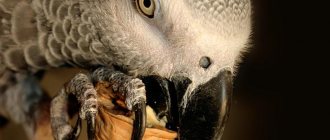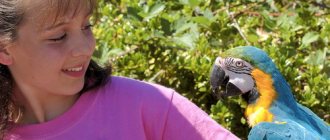- home
- Parrot
- FAQ
04/22/2019 The decision to get a parrot cannot be made spontaneously. You need to take into account a lot of nuances so as not to be disappointed later. There are often cases when a purchased parrot has to be returned to the store. Another outcome, much sadder, is that the bird dies from improper care.
To prevent this from happening, you need to ask in advance how the bird should be cared for, what its character is, how safe it is when there is a small child in the house? The answers to these questions are in this article.
Parrots are best for children and beginners
Having a feathered friend for a child is a way to teach responsibility for a small creature. When choosing a pet, they take into account financial capabilities and living space. It matters what the child’s age and needs are.
Often a child asks to buy a large, beautiful and talking parrot, “like in a fairy tale.” A cockatiel or gray requires a large cage and expensive food. Will the family budget allow it to withstand such waste? Is there a place to put the cage? How comfortable will the bird feel? The answers are not always positive.
A compromise solution may be to buy a budgie. It is small in size, energetic and cheerful, and comes in a variety of colors. You can teach how to talk. If you give your parrot proper care, it will live 12–15 years.
Those who have not kept birds at home also start with wavy birds, even if their housing allows them to choose a large breed of parrot.
Who will take care of the bird?
If the child is under 10 years old, then it is the parents who will take care of the bird. They will clean the cage, feed the parrot, change the water and do the training. The child will only observe these actions and also play with the already tamed and calm bird.
If the child is over 10 years old, then he can take care of the parrot on his own. But for this you buy a small or medium bird. Parents must monitor how well their child cares for their pet.
Teenagers who are over 15 years old can take care of even a large parrot. They are fully involved in caring for the bird, but if they cannot cope with the complex nature of the pet, then the parents will have to help the child.
Budgerigars
Wavys are unpretentious, get used to hands, and willingly contact people. These birds can be taught to reproduce up to 200 words. The child will also be able to study.
Signs by which you can choose a healthy and young budgie for your home:
- The beak of a male less than 6 months old is pink-violet in color, which then turns into blue and dark blue.
- The young female has a beak that is initially soft pink, then it gradually darkens and becomes brown.
- Birds up to 4 months of age have black waves on their heads; over time they disappear or become invisible.
- A healthy bird is clean, not contaminated with droppings, the feathers are smooth, and the behavior is active.
If the goal is to teach a parrot to talk, it is advisable to purchase a boy. Females are reluctant to talk. The cost of a bird is 500–3000 rubles. Males are more expensive.
You should immediately refuse to buy a shaggy parrot sitting motionless on a perch, no matter how much you like it.
Canary
It is a member of the finches family and, like finches, does not tolerate manual handling well and needs a spacious flight cage.
On the other hand, these are solitary birds and can fight if kept in the same cage. The male canary's song is melodic, but the size is small, so the likelihood of noise is minimized.
View overview
LENGTH : From 12 to 20 cm
WEIGHT : 14-28 g
PHYSICAL CHARACTERISTICS : Bright yellow (most common), red, orange or white feathers; some varieties are richly combed on the head or boast beautiful frilled feathers.
Myths about Birds
cockatiels
When financial capabilities allow you to choose a bird that is more expensive than the wavy and larger, you can consider a medium-sized parrot - the cockatiel.
Their colors are not as rich as wavy ones. The colors are gray, yellow, and ivory. The head is crowned with a funny crest. A long, pointed ponytail completes the look. The cockatiel is distinguished by its elegant beauty, emotionality, and tameability. The average price is 3500 rubles.
Word learning is low. Bird owners will need patience to teach their cockatiel to speak human words. But males can imitate the song of songbirds.
Males are distinguished by their “rosy” cheeks and larger dimensions. Females are smaller, their cheeks are pale, and their crest is not as lush.
Kakariki
The peculiarity of this type of parrot is that these parrots prefer not to fly, but to jump and run. Active, rarely sit in one place. If you let the kakarika run around the apartment, it may get stuck in the most inaccessible places.
- easy to tame;
- females are much calmer than males, males are terrible bullies;
- fearless and curious;
- flocking birds.
Size and weight: 25-35 cm, 100-150 g.
How long does it live: 15-20 years.
Price: from 4,000 rub.
Lovebirds
The lovebird breed is diverse.
Common:
- Collared ones are distinguished by an orange “necklace” that stands out against a black background. The breast is yellow, the rump is ultramarine.
- Pink-cheeked parrots have a very beautiful color with a predominance of rich green with a blue tint. But what is most striking is the combination of this color of the plumage of the body with the head. Bright red forehead, pink cheeks and throat. The male has an advantage in color intensity, but the female is larger.
- Lilianas are similar to pink-cheeked ones, but the color is even brighter. The body is dark green at the top and lighter green at the bottom. You can't tell them apart by gender.
- Masks have variegated bright colors with a predominance of orange, with bright green wings and a dark head. Considered the most beautiful.
- Red-faced are grass-green in color and have an orange head. Females have a yellowish-green main color.
- Grey-headed lovebirds have a green body and, as their name suggests, a light gray neck and head.
- Fischer's lovebirds combine green, blue and yellowish-orange colors. There are no external differences between individuals of different sexes. In terms of price, it is the most expensive subspecies of lovebirds.
- Black-cheeked look very elegant due to the gray head and rich orange plumage on the chest.
If you keep one parrot and don't give it constant attention, it will get bored. It can be tamed to sit on your hand and respond to its nickname. But like a wavy, he will not show any special zeal for contacts with a person. The average price is 10 thousand rubles.
It is impossible to teach an adult lovebird to talk. Their beak is very strong, and they can peck painfully if they don’t like something.
These birds constantly and very loudly “cackle” among themselves, which is not welcome in all families. Such parrots are not suitable for an apartment where they like peace.
Where can I buy
You can buy a small parrot in a nursery, at the market or in a pet store, as well as from private owners. The cost of a budgerigar in nurseries varies from 600 to 5,000 rubles, and from a private owner you can buy a parrot from 500 to 2,000 thousand rubles.
The price for a lovebird varies from 1,500 to 6,000 thousand rubles, and prices are affected by the region of residence, age and other characteristics of the parrots. If you need to buy a passerine parrot, you will have to spend a large sum, since the price starts from 2.5 thousand rubles, which is due to the rarity of the breed.
Large parrots
Large breeds need space. Such parrots feel better at home or in a spacious country house than in a cramped apartment. It will definitely not be boring with such birds, but they need more expensive food and a larger cage. The most trainable is the Gray. Learning 500 words is not a problem for him. The cockatoo loves to imitate humans and is very artistic. Amazon is calmer, can learn 200 words and is loyal to a person.
To finally decide which parrot is best to get, you need to familiarize yourself with the characteristics of the breed.
Jaco
Its weight is approximately 0.5 kg, its height is 0.4 m. The red-tailed gray gray cracks coconuts like seeds with its powerful beak.
Gray color:
- The body is gray;
- white “glasses” around the eyes;
- the tail is bright red.
High intelligence is confirmed by talkativeness. He willingly approaches people, trusts people, and allows himself to be petted. Recognizes the owner. Lives up to 30 years. If you need to choose a parrot for conversation, then this is the best option.
This bird feels better outside the cage. But he knows perfectly well that this is where he needs to eat, sleep, and go to the toilet. The average price for poultry is 150 thousand rubles.
Jaco is not an easy bird. You need to look after her, love her, pay attention to her. This bird is not for children or beginners. When living in an apartment, it is better to get a budgie.
Cockatoo
It is difficult to imagine more artistic birds than cockatoos. Just perfect as a cheerful friend. Loves the company of people. He is distinguished by cunning and quick wit. You will master 400 words with regular practice.
He will learn to dance, if necessary, and sing, and master circus tricks. It's fun to tease family members.
The yellow-crested cockatoo has a white body. Expresses emotions by spreading a yellow mohawk. Half-meter individuals weigh up to 1500 g. They can live for half a century. The average price is 100,000 rubles.
Amazon Muller
Muller's Amazon is unlikely to be a good purchase for uninformed people. A bird weighing 750 grams and 40 centimeters tall can show aggression. The beak is powerful, there are many ambitions. Needs good food, space, and requires attention.
For an Amazon, you need not just a cage, but a separate room. The base color is green.
Intelligence is high. If the Amazon wants, he can outplay the cockatoo in showing tricks. But the bird is quite capricious and lazy. She loves to eat delicious food, fly wherever she pleases and follow her owner.
Such a parrot feels like the master of the situation in the house. You need to be able to handle and train him, otherwise the result will be sad, since he loves to sort things out with the help of a hard beak.
If a bird falls into the hands of an experienced breeder, it will become a wonderful imitator of birdsong, musical instruments and the human voice.
Quaker
Quakers are not as large as the Amazons, and in character they are completely the opposite. A 30-centimeter bird needs a large cage and the attention of its owner. They learn easily, love to chat, imitate human speech and mimic everyone around them.
But the Quaker will not impose his society. Lives 20–30 years. These are peace-loving, “intelligent” birds who see people as friends.
Pet selection criteria
The main criterion is whether you can create a comfortable living environment for him.
Which parrot to choose?
These concepts include:
- Space - the cage should be of such a size that the parrot can move in different directions in it. Some large birds can only live outside the cage.
- Humidity, light and temperature conditions - for tropical birds it is important to have a warm room, additional illumination with a UV lamp, and a complete absence of drafts.
- Proper diet - there are vegetarians, there are omnivores, but they all need fresh, high-quality food, which can be expensive.
- The presence of a complete set of necessary accessories - from the already mentioned cage to toys, swings, feeders, drinking bowls and other pleasant little things.
The rest - the bird must be healthy, not enter into irreconcilable conflicts with the rest of the household and pets, and also not irritate the owner beyond measure. This is especially important to keep in mind. A screaming parrot (and they are mostly like that) is something that not every person can get used to. And don’t be fooled by the fact that during the purchase he was silent and behaved in an exemplary manner. Therefore, if you like silence, it is better to buy aquarium fish.
What does a parrot need?
When thinking about which parrot is best to get, you need to consider that any bird needs a cage.
Dimensions for each breed are different:
| Breed name | Cage size(cm) |
| budgies | 40x25x40 |
| lovebirds | 60x35x60 |
| gray | 70x50x80 |
| Amazons | 70x50x90 |
| cockatiels | 50x50x65 |
| cockatoo | 60x60x110 |
Wooden perches are installed in the cages. Other material is not recommended, as birds like to taste everything they come across.
The retractable bottom needs to be washed every day, especially for large birds. The cages are equipped with feeders. They buy more drinking bowl. Plastic ones are suitable for budgies, cockatiels and lovebirds. Large birds require metal drinkers.
They buy dry food for feathered pets. The richer the composition, the higher the price. The wavy animals are fed millet, oats, and millet. Lovebirds and cockatiels additionally need sunflower seeds. Large parrots need berries and nuts. The food should not be mixed up.
The cage is equipped with bells, ladders, and other toys.
What sizes are there?
The sizes of popular domestic parrots are very diverse: budgerigars and lovebirds are 15-17 cm, compared to them, macaws are simply giants (about 80 cm). Somewhere in the middle of this scale are cockatoos.
In the case of parrots, size matters: you will have to think about how comfortable the pet will be in the area of the house that you can allocate to it. And some people just can’t stand confined spaces at all. Therefore, the smaller the apartment, the smaller the bird should be.
top 10 parrot breeds
Parrot in the family: pros and cons
Before buying a parrot, you need to weigh the pros and cons.
Positive aspects of having a bird in a house or apartment:
- The feathered one lifts your spirits and distracts you from the drabness of everyday life;
- will become an attentive interlocutor;
- brings surprises every day and diversifies life;
- there will be a living creature in the house who joyfully greets the owner.
It seems incredible, but parrots sense when their owner is sad and make efforts to cheer them up.
The disadvantages are the following:
- The cage and surrounding area must be cleaned daily;
- sometimes you will have to scrub stains off furniture;
- curious birds can chew through wires, damage indoor flowers and tear wallpaper;
- In the morning it won’t let you lie in the owners’ bed, it will wake you up with a joyful cry.
In order for a parrot to talk and behave “decently”, you need to work with it every day, and at the same time not raise your voice.
Male or female - let's pair
Some species live quietly in celibacy throughout their lives. At the same time, males can limit themselves to periodic platonic flirtations with the owner or mistress, and are very happy with that.
Females, even in the absence of males, can make a nest. By the way, this is one of the ways to determine the sex of a bird. Girls begin to put twigs or paper torn into strips under their tails.
If you decide that your parrot is fine without a mate, be prepared for the fact that you will become his life partner. At the very least, he will need much more attention than if you decide to buy him a soul mate.
https://www.youtube.com/watch?v=7y6cc7C2r8w
Some are already sold in pairs - most often these are lovebirds and wavy ones. Know! When buying a girl for a male parrot, feel free to put the lady in the cage. If the opposite happens, the parrot will perceive this as an encroachment on her sovereign territory and may injure the new resident boy.
Remember! These birds have a matriarchy
When purchasing a male for a female, buy him a separate cage and transfer the female there. Attempts to “slip” the groom into the bride’s living space can result in a serious fight, plucking of the male and even damage to his skull (don’t forget that even small parrots have sharp and hard beaks). Moreover, in some species the females are larger than the males, so the battle a priori will not be equal.
Rosella
They have a beautiful bright scaly color.
- beautiful gentle voice, emit melodic sounds;
- do not tolerate humidity well, but are resistant to temperature changes;
- difficult to tame;
- difficult to breed at home;
- aggressive towards other species of parrots.
Size and weight: 25-30 cm, 50-60 g.
How long does it live: 15-20 years.
Price: from 8,000 rub.
Another name for this species is African gray parrot. It has a gray plumage, only the tail stands out with bright plumage.
- very smart and quick-witted;
- able to learn up to 1000 words;
- demanding conditions of maintenance and care;
- artistic, funny imitations of other pets;
- They need training, otherwise they will be angry and impudent, and may show aggression.
Size and weight: 30-35 cm, 400-600 g.
How long does it live: 40-60 years.
Price: from 60,000 rub.
The largest and most expensive species to keep at home is the hyacinth macaw.
- maintenance requires a huge enclosure or a whole room;
- artistic, funny imitates other pets;
- loud and touchy;
- make loud and harsh sounds;
- require a lot of attention;
- They love their owner very much and become attached to him.
Size and weight: 60-70 cm, 1000-1500 g.
How long does it live: 50-60 years.
Price: from 50,000 rub.
